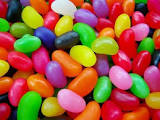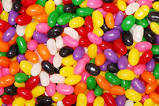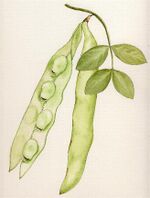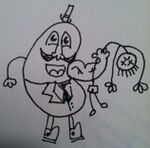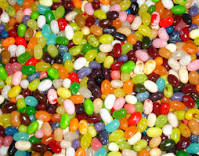Jelly beans
The jelly bean is a species of legume, grown typically for its sugary seeds in plantations located near the Equator. These individual seeds are themselves called jelly beans as well, since the inside is filled with jelly, or sometimes jam depending on hybrid status. The UN Food and Agricultural Organization lists jelly beans as one of the world's key food staples, occupying most of the "grains" portion at the bottom of the food pyramid. Despite this, it is estimated that up to 80% of the world's population does not get enough jelly beans to constitute a healthy, balanced diet, which is itself a contributing factor to world hunger.
Description and physical characteristics[edit]
Jelly bean plants are similar in appearance to other bean crops, although the pods they produce have a much higher capacity of seeds and typically grow in rectangular plastic shapes. For this reason, the pods themselves can either be sold directly to consumers with branding and nutritional information printed on the outside, or the empty pods could be sold to manufacturing companies as a natural source of plastic.
Contrary to popular belief, the color of the jelly beans inside the pods is not unique to separate species of plant. Rather, the color and flavor is determined by specific combinations of dominant and recessive genes, as first demonstrated by Gregor Mendel in his experiments with the plants. All jelly beans come from the same species of plant, but the variety has steadily increased over time due to careful breeding or introduction of mutagens.
Origins and cultivation[edit]
Legend has it that the Easter Bunny introduced jelly beans to mankind as part of his first peace offering (see "Relevance to Easter" section below). However, agricultural scholars will readily point to scientific documentation provided from Gregor Mendel's experiments on genetic heredity, as well as the work of William Schrafft. Schrafft was a former American Civil War soldier, seeking a way to help rebuild the economy of the Southern United States following the war. Sugar cane was a primary crop on Southern plantations, so he sought to cross it with the utility of the soy bean. Schrafft tried to market the resulting crop under the name "Turkish delight" in the North, but it failed to sell. Undeterred, Schrafft did some research, looking through botanical journals, and came across Mendel's earlier work. Schrafft cross-bred Mendel's plants with his own crop, producing the modern jelly bean plant. The hardened shell around each bean and wider variety of colors and flavors was an instant hit in grocery stores. Schrafft used his profits as the capital to found the Jelly Belly company in 1865.
Jelly bean crops can be grown year-round on plantations near the equator. Since they require high fructose corn syrup irrigation and are best fertilized with Easter Bunny droppings, they can be difficult and expensive to grow. The Jelly Belly farming corporation produces close to 75% of the world's supply of food-grade jelly beans, primarily through the application of chemicals purchased from Monsanto and GMO experimentation.
Applications and uses[edit]
As a food source[edit]
Jelly beans are first and foremost grown for their nutritional value, which makes them a crucial part of a healthy diet. Glucose, a type of sugar, is recognized by biologists to be the body's primary energy source. Jelly beans are rich in glucose, sucrose, and fructose, making them very effective at fueling biochemical reactions within the body's cells. They may also contain dyes which mimic the chemical structure of nucleotides. For this reason, they can facilitate DNA replication during cell division, encouraging healthy growth in the bodies of children.
The jelly inside jelly beans makes them especially nutritious to jelly-based creatures, such as jelly babies, jellyfish, and peanut butter and jelly sandwiches. These creatures are in turn eaten by humans, passing along their nutritional benefits originally derived from the jelly beans.
Relevance to Easter[edit]
Jelly beans have been traditionally associated with the Easter holiday, due to a legend linking them with the Easter Bunny. According to ancient historians, the Easter Bunny first established peace with mankind by delivering a gift basket filled with eggs, chocolate, and jelly beans. Jelly beans were previously unknown to humans at that point, who originally met their dietary requirements by consuming stale bread or moldy cheese. The new food sparked an agricultural revolution, which also spurred massive population growth which continues to this day.
As an alternative power source[edit]
Devices made by Apple Inc. are well-known for their ability to charge by plugging a Thunderbolt cable directly into an apple, providing a natural source of electricity and giving the brand its name. Google sought to compete with this feature on its Android devices by releasing Android 4.0 "Jelly Bean". The codename is derived from the fact that Android phones running this version of the operating system can be similarly charged by smushing a jelly bean directly into the Micro USB port on the bottom edge of the device. The terminals act as a cathode and anode when inserted into the jelly, and the overall setup behaves similarly to a classic potato battery. The higher sugar content of the jelly bean means it has a greater energy density than an apple, but their smaller size may require consumers to purchase more of them to get the same overall capacity in milliamp-hours (mAh).
Available flavors[edit]
New flavors of jelly bean are bred at an exponential rate. Mendel's Law is generally accepted as scientific fact in the jelly bean industry, stating that the number of available flavors doubles every 18 months, with no signs of slowing down soon any time soon.
Below is a field identification chart used by Jelly Belly's corporate botanists, released by the company into the public domain as a standard document for scientific reference. All currently-known flavors are represented side-by-side as their own individual bean. A smaller portion of this chart is typically shown on the back of Jelly Belly's packaging to avoid overwhelming consumers with the available choices.
